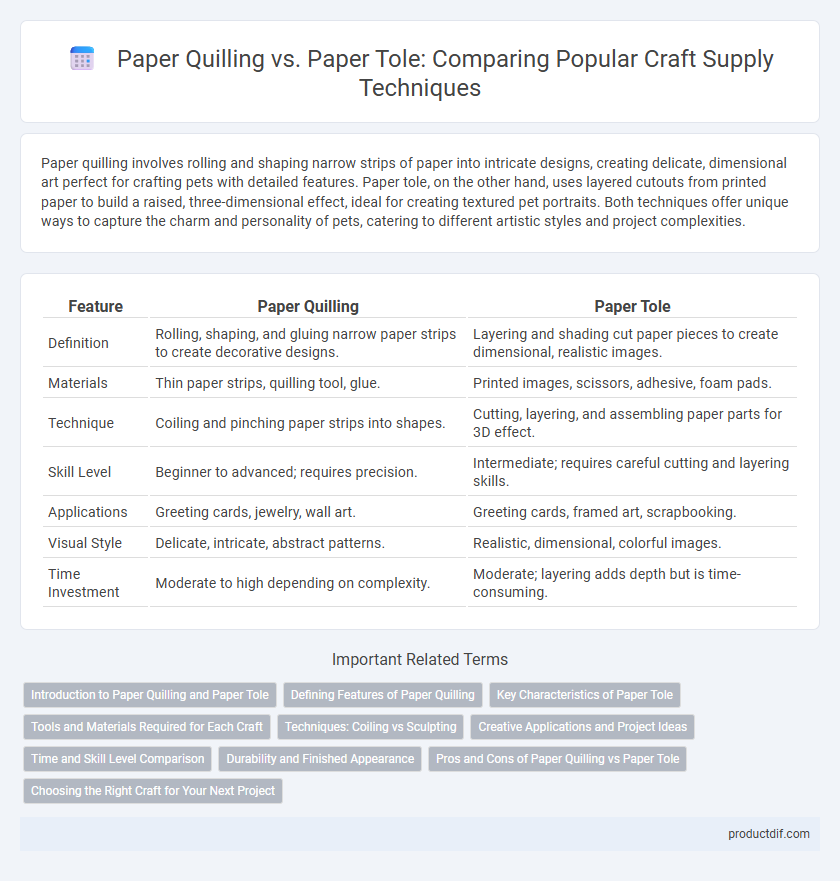Paper quilling involves rolling and shaping narrow strips of paper into intricate designs, creating delicate, dimensional art perfect for crafting pets with detailed features. Paper tole, on the other hand, uses layered cutouts from printed paper to build a raised, three-dimensional effect, ideal for creating textured pet portraits. Both techniques offer unique ways to capture the charm and personality of pets, catering to different artistic styles and project complexities.
Table of Comparison
| Feature | Paper Quilling | Paper Tole |
|---|---|---|
| Definition | Rolling, shaping, and gluing narrow paper strips to create decorative designs. | Layering and shading cut paper pieces to create dimensional, realistic images. |
| Materials | Thin paper strips, quilling tool, glue. | Printed images, scissors, adhesive, foam pads. |
| Technique | Coiling and pinching paper strips into shapes. | Cutting, layering, and assembling paper parts for 3D effect. |
| Skill Level | Beginner to advanced; requires precision. | Intermediate; requires careful cutting and layering skills. |
| Applications | Greeting cards, jewelry, wall art. | Greeting cards, framed art, scrapbooking. |
| Visual Style | Delicate, intricate, abstract patterns. | Realistic, dimensional, colorful images. |
| Time Investment | Moderate to high depending on complexity. | Moderate; layering adds depth but is time-consuming. |
Introduction to Paper Quilling and Paper Tole
Paper quilling involves rolling, shaping, and gluing narrow strips of paper to create intricate designs with dimension and texture. Paper tole, also known as 3D decoupage, uses layered cutouts from printed paper or cardstock to build a raised, multi-dimensional image. Both crafts require precision and creativity but differ in technique, with quilling emphasizing coiled shapes and tole focusing on layered collage.
Defining Features of Paper Quilling
Paper quilling involves rolling, shaping, and gluing narrow strips of paper to create intricate, raised designs characterized by delicate coils and detailed patterns. This technique emphasizes fine, precise manipulation of paper strips to form dimensional artwork, often used for cards, decorations, and framed art. Unlike paper tole, which layers cut paper pieces to achieve a 3D effect resembling painting, paper quilling focuses on the rhythmic arrangement of thin paper coils for texture and visual interest.
Key Characteristics of Paper Tole
Paper Tole is a three-dimensional paper craft technique that involves layering multiple cutouts of the same image to create a raised, textured effect, enhancing depth and detail. This method uses thick cardstock or specialty paper to ensure sturdiness and allows precise shaping for realistic, intricate artwork. Unlike Paper Quilling, which uses rolled strips of paper to form designs, Paper Tole emphasizes dimensional layering and sculpting to bring images to life.
Tools and Materials Required for Each Craft
Paper quilling requires thin strips of colored paper, a slotted quilling tool, tweezers, and glue to create intricate coiled designs. Paper tole involves using printed or hand-painted paper, sharp craft knives, foam pads, and adhesive to layer and sculpt images for a three-dimensional effect. Both crafts demand precision tools but differ significantly in the types of paper and cutting or shaping instruments used.
Techniques: Coiling vs Sculpting
Paper quilling involves coiling narrow strips of paper into intricate shapes and patterns, emphasizing precision and delicate manipulation to create detailed designs. Paper tole, or 3D decoupage, employs sculpting techniques by layering and molding paper elements to produce dimensional artwork with depth and texture. Both crafts require distinct skills: quilling focuses on the controlled rolling and pinching of paper coils, while paper tole demands careful cutting, shaping, and assembly of multiple paper layers.
Creative Applications and Project Ideas
Paper quilling involves rolling and shaping narrow strips of paper to create intricate designs, making it ideal for delicate decorations like greeting cards, jewelry, and framed art. Paper tole, also known as 3D decoupage, uses layered paper cutouts to create depth and dimension in images, perfect for shadow boxes, home decor, and personalized gifts. Both crafts offer diverse creative applications, with quilling excelling in fine detail work and paper tole providing rich texture and volume for artistic projects.
Time and Skill Level Comparison
Paper quilling requires moderate time investment and beginner to intermediate skill levels, making it accessible for crafters seeking detailed, delicate designs. Paper tole demands more advanced skills and greater time commitment due to its intricate layering and dimensional effects. Beginners often find paper quilling more approachable, while experienced artists prefer paper tole for its complexity and depth.
Durability and Finished Appearance
Paper quilling creates intricate, delicate designs by rolling and shaping thin strips of paper, offering a lightweight and textured finished appearance ideal for decorative art. Paper tole involves layering and shaping thicker paper or cardstock to create dimensional, robust compositions with enhanced durability suitable for framed artwork and functional crafts. While paper tole provides a sturdier, more enduring finish, paper quilling excels in detailed, elegant aesthetics with a lighter structural feel.
Pros and Cons of Paper Quilling vs Paper Tole
Paper quilling offers intricate 3D designs with minimal material use and lightweight finished pieces, making it ideal for detailed decorative crafts, but it can be time-consuming and requires patience. Paper tole involves layering multiple cutouts to create more dimensional and textured art, providing durability and a striking visual impact, but it often demands precision cutting and heavier materials. Choosing between paper quilling and paper tole depends on the desired art style, complexity, and project durability needs.
Choosing the Right Craft for Your Next Project
Paper quilling involves rolling and shaping narrow strips of paper to create intricate 3D designs, ideal for adding delicate detail to cards and decorations. Paper tole, also known as 3D decoupage, layers multiple cutouts of the same image to build a dimensional effect, perfect for creating lifelike art pieces. Selecting between paper quilling and paper tole depends on your desired texture and complexity; quilling works best for fine, precise embellishments, while tole suits projects that require bold, sculptural visuals.
Paper quilling vs Paper tole Infographic

 productdif.com
productdif.com